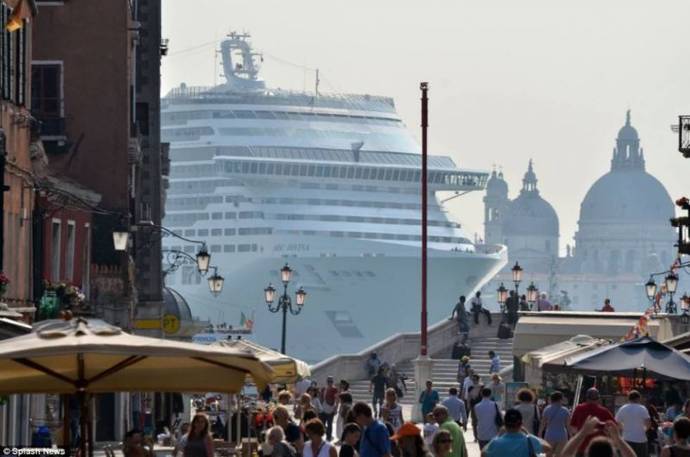


VENICE – In a fiery new book described as a “pamphlet,” the authoritative archaeologist Salvatore Settis [2] attacks Venice. For Settis, the beloved but troubled lagoon city has now become nothing more than a merchandise mall, in which there is just one inhabitant for every 600 tourists trotting through.
The decline of the once glorious republic of Venice [3], which literally ruled the waves at its peak in the mid-15th century, is hardly a novelty. Following Napoleon [4]'s defeat in 1815 the Austrian general Metternich wrested control over Lombardy, Tuscany, the duchies of Modena and Parma, and the Veneto, and all became Habsburg provinces ruled from Vienna. The two Northeastern regions, Lombardy and the Veneto, were the most densely populated, and had rich agricultural production. But Lombardy was also a crossroads on the Italian peninsula and had, as a result, developed such considerable commercial savvy that its capital, Milan, was the wealthiest commercial city in Italy – and still is.
The Veneto was left behind, and harsh Austrian taxation aggravated the situation. By 1848 the Kingdom of Lombardy-Venetia, as the Habsburgs called it, was home to one-sixth of all the subjects under their rule, but its citizens provided the monarchy in Vienna with almost one-third of their tax revenues.
By the mid-19th century, the industrial revolution was in full sway, but the two main ports, the Lido and Treport, could harbor only small craft. The difficulties of transport by gondola and of obtaining such industrial essentials as fresh water and coal boosted the cost of manufacturing goods of any type. Furthermore, once goods manufactured in Venice reached the mainland by boat, the roads toward markets were poor.
It was a crushing blow that the inland Lombards, with their bustling new factories, favored the port at Genoa while the Austrians promoted the port at Trieste at the expense of Venice. The industrial revolution had left Venice "on the periphery," in the words of Venetian historian Adolfo Bernardello. By 1848 the population had dwindled by a quarter, from 126,000 to under 106,000. Ironically, this very aura of decadence attracted American visitors like Henry James, troubled by the new American manufacturing modernism, who came to live in Venice later in the century.
Today, as Settis points out in his Se Venezia Muore (If Venice Dies [5]), published by Einaudi, the local population had sunk to only 56,684 as of June 2014. In an almost terrifying contrast, the city has 8 million visitors annually. The locals are elderly; in the year 2000, 1,058 Venetians died while only 404 were born. “Its forgotten past weighs upon today’s Venice, but since a shroud wraps everything in a long and indistinct night, there is no complicity, save for indifference,” writes Settis mournfully.
Another contemporary problem: he points out that the rich and famous purchase fine Venetian dwellings to use as a vacation home, but for only five or so days a year. The whole city thus risks becoming, itself, a corpse, which awakes for half a day every day with thousands of people wandering past pricy boutiques and then leaving the city empty, all more or less at the same time, writes Settis. In other words, Venice is becoming a watery Pompeii [6].
Its administrators did little to improve the situation – on the contrary. On Nov. 5 it was announced that Emilio Spaziante [7], an ex-general of the tax watchdog police Guardia di Finanza [8], has plea-bargained a sentence of four years of prison and confiscation of circa $600,000 for his (now admitted) role in the kickback scandal over a giant construction project of mobile dykes in the lagoon called the Mose. Roberto Meneguzzo [9], former administrative boss of the Palladio Finanziaria group [10], has also accepted a deal for 2-1/2 years of prison. Prosecutors accused Meneguzzo of having mediated in the corruption scam between Spaziante and the Consorzio Venezia Nuova in an effort to obtain more public funding for the Mose project. The Italian press is also pointing out that Meneguzzo had been among those bidding for control of the insurance mega-group Fondiaria Sai [11].
Source URL: http://440468.6bgr9ubv.asia/magazine/focus/op-eds/article/venice-dying-not-quite-it-becoming-mall
Links
[1] http://440468.6bgr9ubv.asia/files/venezia31415286514jpg
[2] http://it.wikipedia.org/wiki/Salvatore_Settis
[3] http://en.wikipedia.org/wiki/Venice
[4] http://en.wikipedia.org/wiki/Napoleon
[5] https://www.amazon.com/If-Venice-Dies-Salvatore-Settis/dp/1939931371
[6] http://en.wikipedia.org/wiki/Pompeii
[7] http://it.wikipedia.org/wiki/Emilio_Spaziante
[8] http://en.wikipedia.org/wiki/Guardia_di_Finanza
[9] http://en.wikipedia.org/wiki/Roberto_Meneguzzo
[10] http://www.palladiofinanziaria.it/en/
[11] http://en.wikipedia.org/wiki/Fondiaria-Sai